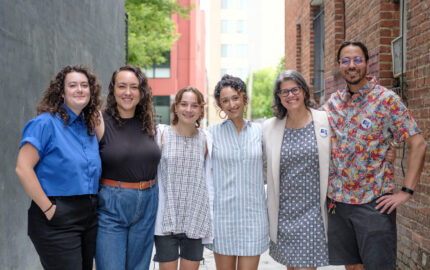When I was a teenager, I decided what I wanted to do if and when I grew up. To say that I wanted simply to become a journalist—the job I now hold at the Philadelphia Daily News more than three decades later—wouldn’t be 100 percent accurate. Specifically, I wanted to be one of the Boys on the Bus.
Though heavily influenced by Bob Woodward and Carl Bernstein, to the point where I ignored my raging hormones to read “All the President’s Men” in the summer of 1974 when I’d just turned 15, the tale that really pushed me in this direction was actually a tome that came out around the same time, “The Boys on the Bus,” by Timothy Crouse.
It’s a bit ironic since this book about the life led by political reporters following George McGovern and Richard Nixon in the 1972 campaign wasn’t all that flattering. And buried in the book’s colorful prose is a withering critique of how U.S. elections are covered. But it was the life I wanted—with its journalistic camaraderie and a chance to be a front row witness to history. Even the brutal travel seemed romantic at the time.
Through my college days—from what I wrote on my applications to when I walked through the front door of the Brown Daily Herald, then with summer internships and early jobs—it still would not have been accurate to say I wanted to become just a newspaper reporter. I planned on being R.W. Apple or David Broder, a shaper of big national stories. I suspect tens of thousands of my peers who went into journalism during that time shared this ambition. We weren’t going to be satisfied by covering a town meeting when 1600 Pennsylvania Avenue loomed so large.
I’ve been thinking about my early life career ambitions a lot lately, because I’ve been attending a lot of journalism conferences and doing research for a book I’ve been writing on media reform called “The News Fix.” At each conference the participants fixate on the same point: With the Internet in play, a small group of players—The New York Times, The Washington Post, The Wall Street Journal, the BBC—will dominate the big stories on the world stage and in our nation’s capital.
For the rest of us, journalism will die if it does not become more local, or even something called “hyperlocal.” The theory goes like this: readers seeking out world or national news on the Web won’t bother with local sites or their city’s daily newspaper when they can go directly to global sites on the Internet. What is missing—and what nytimes.com can’t offer—is intensive reporting of local news about what’s happening, for example, in Philadelphia’s schools or with Spokane’s city council or with the eight-car pileup that just took place on a heavily traveled commuter highway.
In more sprawling, faceless exurban communities, especially in the Sunbelt, the move is for hyperlocal reporting, akin to what a leading pioneer in the field—Kate Marymont, executive editor of The News-Press in Fort Myers, Florida—acknowledged can be “cat stuck in a tree” journalism at times. This kind of reporting—short bursts of neighborhood-type stories, frequently updated—is being carried out by a new breed known as “mojos,” young, not exorbitantly paid reporters who file words and pictures and sound more often than not from their car using a laptop and mobile phone. With its promised quickness and reduced cost, it resembles more a pizza delivery strategy than the shoe-leather model of reporting we grew up with.
The Missing Pit Stop
To say that I have mixed feelings about this movement to save the newspaper industry would be an understatement, even though the goal here is to save my ever-endangered job. Intellectually, I agree fully that the only thing that makes sense in the Internet age for a newspaper like The Philadelphia Daily News is to cover the living daylights out of new streetlights for the Platt Bridge or applications to open neighborhood charter schools.
On an emotional level, I’m going on 49 years old, and I have a lot of friends around my age who have survived the surge in newsroom layoffs and are still working in an ink-stained newsroom somewhere. Not one of us wanted to be covering local news at our age (or, for that matter, at any age.) But we’ve been there, done that. To be brutally honest: For an ambitious journalist, the only way to get through a four-hour suburban school board meeting—even at age 22—is to keep repeating the mantra “this, too, shall pass.” In other words, treat this day’s assignment as just a boring but necessary pit stop on the road to Moscow or Beirut.
During a brief stint in the legendary Room 9 of New York City Hall in the early 1990’s, there was a metro reporter for The New York Times who was actually nicknamed “Pit Stop,” because he’d told all his friends that covering New York City was just a kind of a speed bump before the Middle East beat, which for him it was. Now our bosses, and all the journalism-reform gurus, tell us that “the pit stop” has morphed into the finish line.
There’s a very real problem here, a serious disconnect. For the past couple of years, a number of change-minded journalists, academics and engaged citizens have been discussing a lot of great ideas for saving the news business: Teaching reporters how to wield video cameras on assignment, to file breaking news for the Web, to use a blog to cover a local beat like mass transit, or work as moderators with engaged citizen journalists.
What’s almost never mentioned in these discussions is the human factor. After all, one of the underlying tenets of saving newspapers is supposed to be rescuing the livelihood of working journalists. But do the rank-and-file of most metro newspapers in 2007, people in their 30’s, 40’s, and 50’s, actually want to do these things—cover local news for life, with no chance of parole?
Some, perhaps. Most, no. Definitely not me. The irony for me is that I became involved in the media reform movement—and now I am writing a book on the topic—because of my early interest in blogging. (I write a blog, Attytood.com, at the Daily News.) And the main reason I wanted to write my blog was because in my mid-40’s I found myself at an urban tabloid newspaper that was already too local in its reach for my ambitions. What I wanted was a broader platform to express my dismay about the war in Iraq and some of the abuses I felt were happening at the national level after 9/11; I didn’t want to write about the troubles with SEPTA buses.
Knowing my peers in journalism as I do, I’d say that for the local journalism movement to succeed within the existing newsroom, there’s going to need to be a very different system of rewards to replace the dreams of Beltway RELATED WEB LINK
Will Bunch's blog, “Attytood”
– attytood.com/punditry or a glamorous foreign beat. In fact, the rewards of the more pointed kind of journalism that blogging allows—the ability to develop a voice and a personality and to connect daily with readers—are considerable. Another route: convince the Pulitzer Prize committee to double the categories for local journalism.
Even this might not be enough for the generation reared with the likes of Woodward and Bernstein and Crouse. As another great writer from that era, Ken Kesey, said, “Either you’re on the bus—or you’re off the bus.”
Will Bunch is senior writer for the Philadelphia Daily News and author of its blog, Attytood. His book about reforming journalism, “The News Fix,” is being published by Vaster Books in early 2008.
Though heavily influenced by Bob Woodward and Carl Bernstein, to the point where I ignored my raging hormones to read “All the President’s Men” in the summer of 1974 when I’d just turned 15, the tale that really pushed me in this direction was actually a tome that came out around the same time, “The Boys on the Bus,” by Timothy Crouse.
It’s a bit ironic since this book about the life led by political reporters following George McGovern and Richard Nixon in the 1972 campaign wasn’t all that flattering. And buried in the book’s colorful prose is a withering critique of how U.S. elections are covered. But it was the life I wanted—with its journalistic camaraderie and a chance to be a front row witness to history. Even the brutal travel seemed romantic at the time.
Through my college days—from what I wrote on my applications to when I walked through the front door of the Brown Daily Herald, then with summer internships and early jobs—it still would not have been accurate to say I wanted to become just a newspaper reporter. I planned on being R.W. Apple or David Broder, a shaper of big national stories. I suspect tens of thousands of my peers who went into journalism during that time shared this ambition. We weren’t going to be satisfied by covering a town meeting when 1600 Pennsylvania Avenue loomed so large.
I’ve been thinking about my early life career ambitions a lot lately, because I’ve been attending a lot of journalism conferences and doing research for a book I’ve been writing on media reform called “The News Fix.” At each conference the participants fixate on the same point: With the Internet in play, a small group of players—The New York Times, The Washington Post, The Wall Street Journal, the BBC—will dominate the big stories on the world stage and in our nation’s capital.
For the rest of us, journalism will die if it does not become more local, or even something called “hyperlocal.” The theory goes like this: readers seeking out world or national news on the Web won’t bother with local sites or their city’s daily newspaper when they can go directly to global sites on the Internet. What is missing—and what nytimes.com can’t offer—is intensive reporting of local news about what’s happening, for example, in Philadelphia’s schools or with Spokane’s city council or with the eight-car pileup that just took place on a heavily traveled commuter highway.
In more sprawling, faceless exurban communities, especially in the Sunbelt, the move is for hyperlocal reporting, akin to what a leading pioneer in the field—Kate Marymont, executive editor of The News-Press in Fort Myers, Florida—acknowledged can be “cat stuck in a tree” journalism at times. This kind of reporting—short bursts of neighborhood-type stories, frequently updated—is being carried out by a new breed known as “mojos,” young, not exorbitantly paid reporters who file words and pictures and sound more often than not from their car using a laptop and mobile phone. With its promised quickness and reduced cost, it resembles more a pizza delivery strategy than the shoe-leather model of reporting we grew up with.
The Missing Pit Stop
To say that I have mixed feelings about this movement to save the newspaper industry would be an understatement, even though the goal here is to save my ever-endangered job. Intellectually, I agree fully that the only thing that makes sense in the Internet age for a newspaper like The Philadelphia Daily News is to cover the living daylights out of new streetlights for the Platt Bridge or applications to open neighborhood charter schools.
On an emotional level, I’m going on 49 years old, and I have a lot of friends around my age who have survived the surge in newsroom layoffs and are still working in an ink-stained newsroom somewhere. Not one of us wanted to be covering local news at our age (or, for that matter, at any age.) But we’ve been there, done that. To be brutally honest: For an ambitious journalist, the only way to get through a four-hour suburban school board meeting—even at age 22—is to keep repeating the mantra “this, too, shall pass.” In other words, treat this day’s assignment as just a boring but necessary pit stop on the road to Moscow or Beirut.
During a brief stint in the legendary Room 9 of New York City Hall in the early 1990’s, there was a metro reporter for The New York Times who was actually nicknamed “Pit Stop,” because he’d told all his friends that covering New York City was just a kind of a speed bump before the Middle East beat, which for him it was. Now our bosses, and all the journalism-reform gurus, tell us that “the pit stop” has morphed into the finish line.
There’s a very real problem here, a serious disconnect. For the past couple of years, a number of change-minded journalists, academics and engaged citizens have been discussing a lot of great ideas for saving the news business: Teaching reporters how to wield video cameras on assignment, to file breaking news for the Web, to use a blog to cover a local beat like mass transit, or work as moderators with engaged citizen journalists.
What’s almost never mentioned in these discussions is the human factor. After all, one of the underlying tenets of saving newspapers is supposed to be rescuing the livelihood of working journalists. But do the rank-and-file of most metro newspapers in 2007, people in their 30’s, 40’s, and 50’s, actually want to do these things—cover local news for life, with no chance of parole?
Some, perhaps. Most, no. Definitely not me. The irony for me is that I became involved in the media reform movement—and now I am writing a book on the topic—because of my early interest in blogging. (I write a blog, Attytood.com, at the Daily News.) And the main reason I wanted to write my blog was because in my mid-40’s I found myself at an urban tabloid newspaper that was already too local in its reach for my ambitions. What I wanted was a broader platform to express my dismay about the war in Iraq and some of the abuses I felt were happening at the national level after 9/11; I didn’t want to write about the troubles with SEPTA buses.
Knowing my peers in journalism as I do, I’d say that for the local journalism movement to succeed within the existing newsroom, there’s going to need to be a very different system of rewards to replace the dreams of Beltway RELATED WEB LINK
Will Bunch's blog, “Attytood”
– attytood.com/punditry or a glamorous foreign beat. In fact, the rewards of the more pointed kind of journalism that blogging allows—the ability to develop a voice and a personality and to connect daily with readers—are considerable. Another route: convince the Pulitzer Prize committee to double the categories for local journalism.
Even this might not be enough for the generation reared with the likes of Woodward and Bernstein and Crouse. As another great writer from that era, Ken Kesey, said, “Either you’re on the bus—or you’re off the bus.”
Will Bunch is senior writer for the Philadelphia Daily News and author of its blog, Attytood. His book about reforming journalism, “The News Fix,” is being published by Vaster Books in early 2008.



